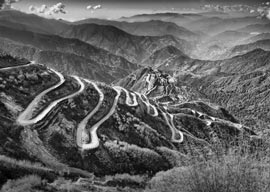
December 03, 2015

Source: Shutterstock
Per Xinhua, China “envisions the Silk Road as a region of “more capital convergence and currency integration.”” It claims that it intends for local currencies to be the dominant means of business deals, not the renminbi; though the latter has already gained wider usage in countries as widespread as Thailand, Uzbekistan, Mongolia, and Kazakhstan. Xinhua clearly and proudly conveys China’s desire to revive the “Middle Kingdom” of Eurasia, with its economic cooperation area spanning in total from the Western Pacific to the Baltic Sea, making for a massive loop linking three continents.
Russia’s cooperation with China was not always planned, Escobar point out. He recalls how Russia tried to join the E.U. but was quickly snubbed. Never mind. China’s new foreign policy is already established: They choose to finance projects in their own ways. And, from a macro point of view, the reemergence”and reintegration”of the Eurasian economic bloc is the mega-hub where all the ambitions of the Chinese (and the other nations) will intersect. It makes the NYSE look a little small, no?
The fact, it is said, that trade rather than military power will unify this vast infrastructure, now being built along the Eurasian corridor, qualifies Eurasia as a so-called “new world order,” at least in theory. Wait ten years and then we”ll see. Trade is the best deterrent against conflict on the world stage, or so the Chinese say that they believe”perhaps in an optimistic moment?
Writing for the Asia Times, where he enjoys a cult following, Mr. Escobar lyrically points out that “Washington may be intent on “pivoting to Asia,” but Beijing has its own plan to pirouette to Europe.”
To conclude: The Polish-American geostrategist Zbigniew Brzezinski best summarizes the Silk Road’s significance as a new economic world order. He does it with a powerful vision of the past and the future”a future that China is not hastening to realize, however, simply because the centrifugal process described here is gaining momentum by the day. Given the great (and unknown) expense of construction of this magnanimous Chinese vision, it distracts one from the trivial chaos of the Chinese stock market. It even overshadows it in scale, and in terms of the aggregate value of all business revenues expected along the Eurasian belt, as projected for the future.
The unity of a defined route encompassing the many countries en route is believed by those present in the region, or those who are well-informed on the matter, to be a process of geographic unification, one that is organic, dynamic, and inevitable. It is history repeating itself, and apparently it’s reached an unstoppable pace. Hence the Chinese modesty on the issue in the media, and hence their patience. The Chinese believe the New Silk Road to be their collective destiny, and destiny needs no convincing.
Brzezinski neatly summarizes the significance of the New Silk Road and its effect on the world order. WARNING: It is an alarming effect indeed, at the very end of the quotation.
Make of his words what you will. It’s a pleasant change from the harping of Western stock analysts over the Chinese market’s free fall, and the temporary suspension of mad profits made from China’s gravy train, which we in the West are happy to consume too. As Confucius might have said, The unforeseen is a shock one must prepare for. The analysts should have known better and considered the unthinkable. Or simply been less greedy.
Here’s Mr. Brzezinski:
Eurasia accounts for three quarters of the world’s known energy resources…. About 75% of the world’s peoples live in Eurasia, and most of the world’s physical wealth is there as well….
Ever since the continents started interacting politically some 500 years ago, Eurasia has been the centre of world power. A power that “dominates” Eurasia would control two of the world’s three most advanced and economically productive regions…[and it] would automatically entail Africa’s subordination, rendering the Western hemisphere and Oceania peripheral….”